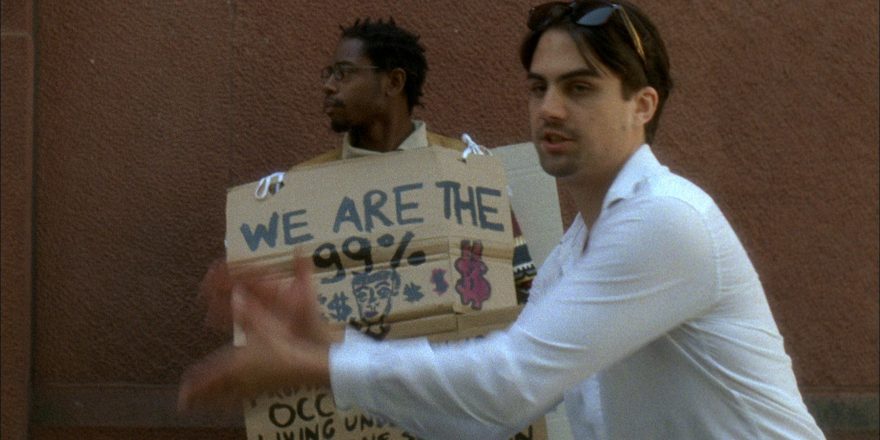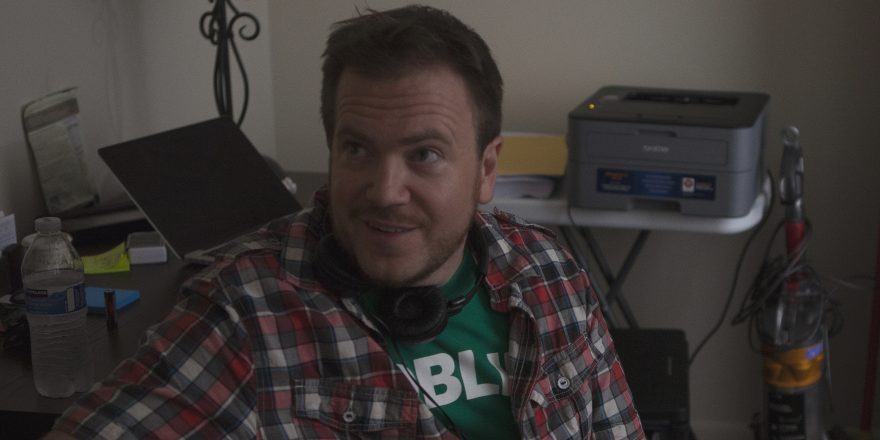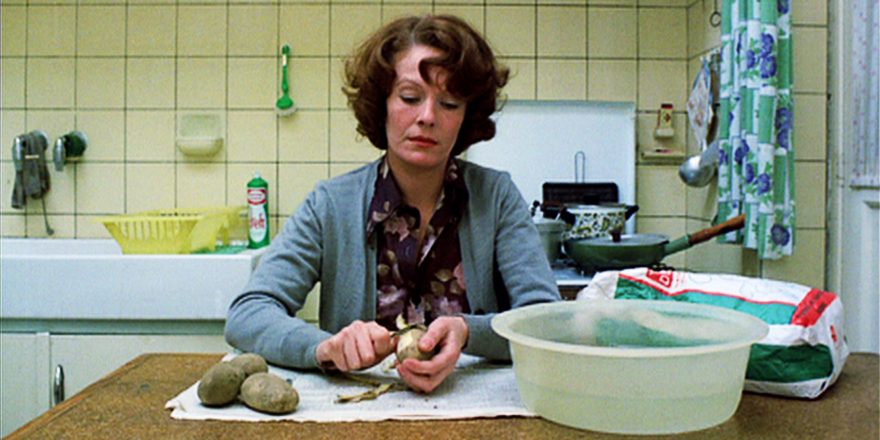Most journalists who have spoken to me about my new erotic drama PVT Chat (starring Peter Vack and Julia Fox and streaming now on most VOD platforms) assume it’s my first feature film. Actually, it’s my third. My first two features never played a single film festival and haven’t been seen by more than a few hundred people (mostly friends and/or curious followers of my rock band, Bodega). They were financial failures (even though they were made extremely cheaply), but you couldn’t call them critical failures because nobody has ever reviewed them. I spent the last decade working on these films and yet their cultural footprint is practically nonexistent.
Despite that, I still believe in them and hope one day I’ll make a movie (or record) that inspires people to seek them out. My early cinematic attempts certainly failed at behaving like normal movies, but to me it is precisely this failure that makes them interesting.
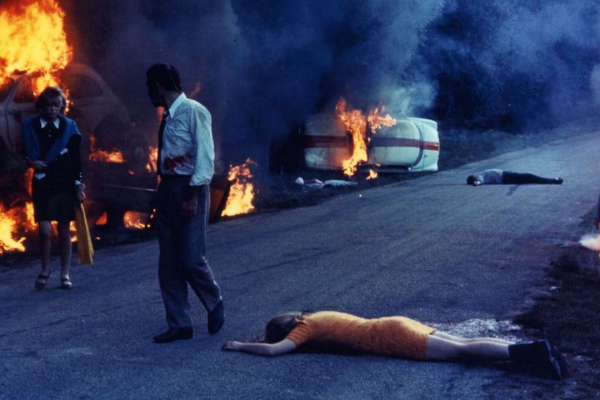
Godard said of Pierrot le Fou (1965), “It’s not really a film. It’s an attempt at a film.” This is a purposefully cryptic statement, but I think I understand what he meant. There is a sketch-like quality to his films from that period. He was less interested in following a particular plot through to its conclusion than suggesting narrative ideas and moving on. He enjoyed employing classical narrative tropes but didn’t want to waste screen time on the proper pacing required to sell those tropes to an audience. Instead he filled his screen time with spontaneous personal, poetic, and political ruminations that occurred to him literally on the day of filming. Many found – and still find – this approach infuriating, but for a select number of Godard disciples, like me, this type of filmmaking is still revolutionary. I remember seeing Weekend during my sophomore year of college at the University of South Carolina and having my mind completely ripped open. Suddenly the world wasn’t a small, mediocre, predictable place – it was full of music and color and philosophy and eroticism. There were people out there genuinely disgusted with the status quo and boldly proclaiming it with style.
Godard’s work is a fulfillment of the dream of the caméra-stylo – a term coined in 1948 by Alexandre Astruc that argued it was theoretically possible for someone to compose a film with as much direct personal expression as exists in prose. In order to achieve this level of expression, one often needs to move beyond the realm of mere plot and narrative naturalism, the principle that what you are seeing on screen is real. (On most movie sets, the filmmakers and actors work overtime to sell this illusion.) Films that focus solely on plot, character psychology, and one literary theme have to direct the majority of their screen time toward plotting mechanics and emotional manipulation of the audience. What you gain in dramatic catharsis you often lose in intellectual honesty. There’s always a tradeoff. I am invested in a cinema of the future that veers toward self-expression, but doesn’t need to avoid dramatic catharsis as Godard’s films did. Certainly many filmmakers my age are working to achieve such a synthesis of intellectual directness and narrative pleasure. Experimentation is required and many “bad” films need to be made to pave the way for future successes.
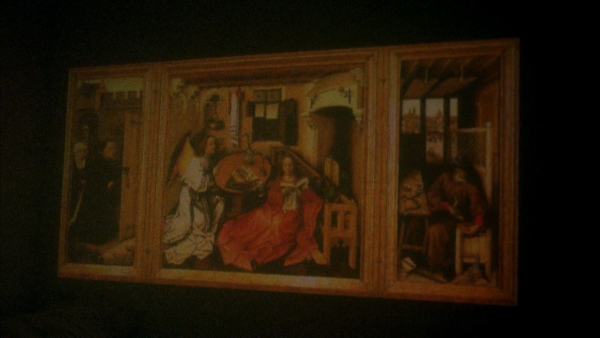
I graduated college in 2010 high on this dream of the caméra-stylo and philosophy (my field of study) and in 2011 started filming my first feature, Annunciation, with experimental filmmaker Simon Liu. Annunciation is an “adaptation” of the Mérode Altarpiece, an early Northern Renaissance oil painting triptych by Robert Campin. The film features three short separate narratives, one for each panel of the famous 15th-century painting. I wanted the performances in Annunciation to be controlled and somewhat surreal, as if the whole film existed in a heightened but slowed-down hypnotic state; I was thinking about Bresson, Ozu, Antonioni and, of course, Godard (particularly his work from the ’80s). There is some plot, but the main goal of the movie was to reveal the miracle of existence in the everyday. And because the Mérode Altarpiece depicts the scene in Christianity where the Virgin Mary was impregnated by light alone, the film had to be shot on 16mm film.
Now picture this: a 22-year-old walks into a conference room in Midtown Manhattan and gives this pitch to a producer who was then investing in thriller movies: “Every time light strikes a piece of celluloid, a miracle similar to the Annunciation scene occurs: an image appears in the likeness of man that redeems our fallen world and reveals it to be the beautiful place that we take for granted in our normal day-to-day.” This wasn’t met with the enthusiasm I was hoping for. “Don’t you see,” I said, “this is a film about the ecstatic of the quotidian! This is a film that audiences will flock to! It could do for Williamsburg and Bushwick what Breathless did for Paris!” Looking back, I am both shocked and charmed by my youthful naiveté, courage and idiocy.
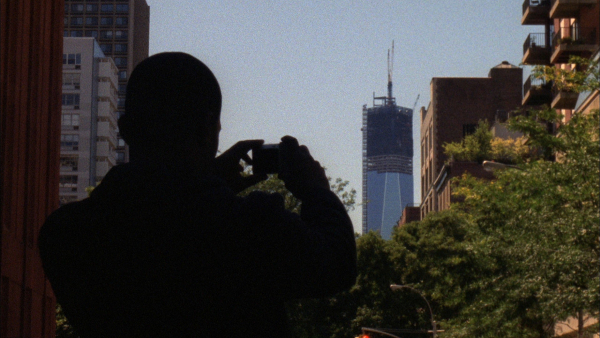
I was laughed out of the room, but the producer was kind enough to wish me good luck and welcomed any future pitches, should I come up with something any “normal” person would want to watch. I never thought of films in the tradition of the caméra-stylo as being elite works only for the gallery or the Academy. I, like Godard before me, have always assumed that audiences are intelligent and long for thoughtful, challenging movies. That belief I carry to this day and thankfully it sometimes seems to be true. How else could you explain the recent success of heady films by Josephine Decker or Miranda July?
Thanks to small donations from family members (and credit cards), I was able to shoot Annunciation without any official backing. I cast the film with a mixture of non-actor friends and some undiscovered Backstage.com talent and dove head first into the production. Right as our principal photography began, Occupy Wall Street gained momentum, so Simon and I spent time at Zuccotti Park filming our actors experiencing the movement. The hopeful promise of OWS seemed to reflect the yearning desire of our film’s protagonists as well as our own idealist cinema experiment.
When the film was finished and edited, I naively assumed that we were well on our way towards global cinematic notoriety. Surely, I thought, this important film that manages to blend fiction with actual footage of OWS would premiere at Cannes or Berlin and the Criterion Collection would issue the DVD shortly after. In actuality, it was rejected from every single film festival we submitted to.
Undeterred, I conceded that maybe there were a few minor structural flaws in the edit. It was probably a little too long and perhaps the three separate narratives would work better if they were crosscut more. A year later, this new edit was again rejected from almost 100 festivals. Stubbornly, I thought that perhaps what could really bring the movie together was a comic voiceover by my then cinematic muse Nick Alden (who is a lead in both Annunciation and my second film, The Lion’s Den). Audiences seemed to ignore the comic tone underlying Annunciation. If only I could unearth it, they wouldn’t be put off by the pretensions to greatness the movie wore on its sleeve. There is nothing so offensive to American audiences as pretentiousness.
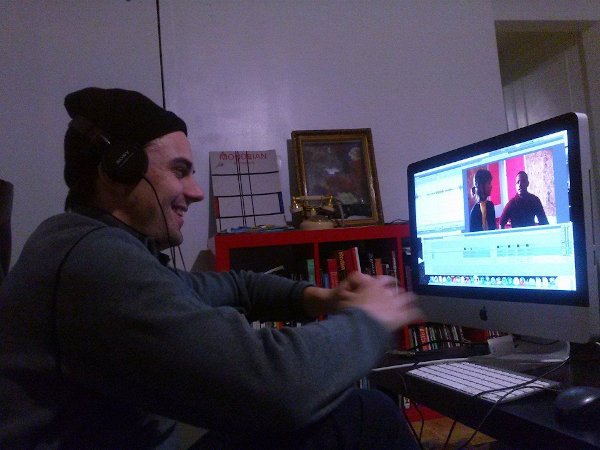
I didn’t send the overcooked voiceover version to festivals. I knew it was forced and worked against the core concept of the film. But it was then that I started for the first time to have doubts about Annunciation. Maybe my film wasn’t as emotional or clever as I imagined. Maybe it was bad? “No,” I decided. The film, whatever its flaws may be, has value. Herculean delusions of grandeur come in handy when you are trying to become an artist.
I opted to edit the film back to its original state, but without some of the weaker, obviously didactic moments, then hosted a few local screenings in NYC (most of them at DIY venues where my rock band would play) and put the film up for free on Vimeo. Around this time, it occurred to me that editing Annunciation had been my film school. Failure is a wonderful learning tool. Editing the same raw material in a myriad of different ways taught me about pacing and tone. Still to this day, when I find myself in a certain state of mind, I open up the Final Cut sessions and do a new edit of the footage just for fun, like some sort of DIY George Lucas tinkering with the past. Last year during quarantine, I did a new edit of Annunciation and uploaded it to Vimeo without telling a single person. It has become my own little cinematic sandbox to play in.
When people did chance upon one of my myriad edits, they often commented that they enjoyed its style but found the acting too unnatural. My response to this was to make my next film, The Lion’s Den, a cheaper HDV feature that doubled as a political farce and an essay about naturalism in cinema. The film is about a group of ding-dong radicals who kidnap a Wall Street banker and plan to donate his ransom money to UNICEF so salt pills can be provided for dehydrated children. The UNICEF plot was drawn from Living High and Letting Die, a 1996 work of moral philosophy by Peter K. Unger. It was both a serious attempt at political philosophy and a total slapstick farce; I was imagining the comedy of errors in Renoir’s The Rules of the Game mixed with the Marxist agitprop of Godard’s La Chinoise.
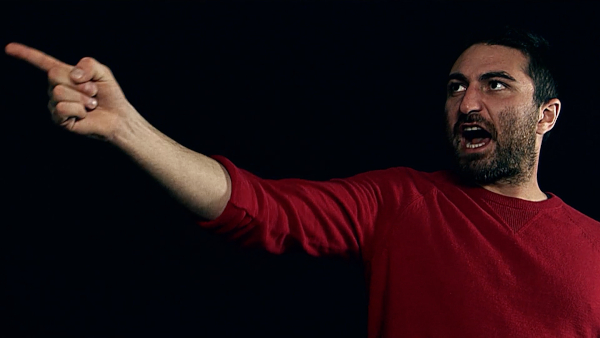
The acting style in The Lion’s Den was purposefully cartoonish; at no point in the film could an audience member believe that what they were seeing was real. I like to think that The Lion’s Den was an attempt at theatre for the camera, part Shakespeare and part Brecht. This was my own personal response to our epoch’s hyperrealism fetish. At the time, I believed that the current obsession with neo-neorealism, mumblecore and reality TV was worth combating. Art with a realistic aesthetic, I thought then, was inherently conservative and accepting of the political status quo (whether the artists were aware of this or not). Art with an imaginative anti-realistic aesthetic, so I thought, was utopian. It opened new vistas and ways of thinking and being. It dared to believe in a more beautiful world than the one we are living in.
The making of The Lion’s Den was extremely difficult. It was by far the hardest thing I have physically done in my life. At the time, I was malnourished and broke, not unlike the character of Jack in PVT Chat; my diet for that month we made the film consisted mostly of coffee, rice and beans, ramen, light beer, and the occasional waffle or fruit smoothie from the vegan frozen yogurt stall I worked at. Unlike Jack, my addiction wasn’t cam girls or internet gambling, but independent filmmaking. I begged, borrowed and scrimped $10,000 to make a film I knew I wouldn’t be able to sell. Despite having some key collaborators near the beginning of the shoot, most of the film was made with just me, the actors and a loyal boom operator, all living together in a house in Staten Island. This meant that I had to assemble all of the cumbersome lights for every setup, handle the art for every scene (which involved a lot of painting), block the scene and direct the actors, throw the camera on my shoulder and film, and then at the end of the day transfer the footage while logging the Screen Actors Guild reports and creating the call sheets for the next day’s scenes. Exhausted both mentally and physically, I often couldn’t stand up at the end of the day’s filming.
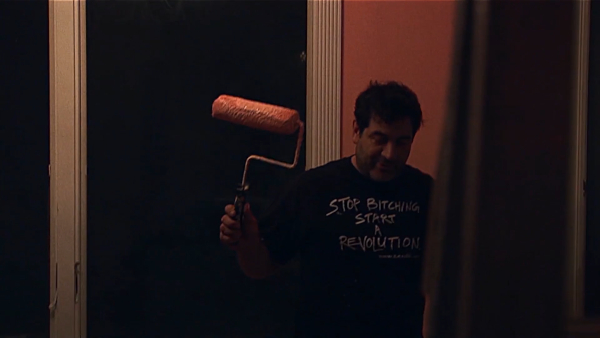
Once we’d wrapped and everyone had gone home, I stood in the middle of our set and played Beethoven on my headphones. Within seconds, I began bawling my eyes out, partly from exhaustion but also from the melancholy that all my friends had left and I was now alone for the first time in a month. I collapsed and slept for hours. When I woke up, it was my 26th birthday. I celebrated by watching Citizen Kane alone and then starting the process of painting the walls back to a neutral white. The actor Kevin Moccia (who has been in all three of my films and actually works as a house painter) heroically came back to set and helped me. I told him that despite all of the agony of the past weeks (my bank account was now in the red, with overdraft fees piling up), I was happier than I had ever been. Working passionately on something that has great value to you is, without a doubt, the key to happiness.
Shortly after returning to the real world and my job at the vegan yogurt shop, I passed out while on the clock and was taken to a hospital by my very supportive girlfriend. Turns out, all I needed was an IV and some nutrients to get back on my feet, but unfortunately the trouble with The Lion’s Den had just begun. At some point, I formatted the production audio memory card and, in one instant, accidentally deleted everything on it. For the next two years, my friend Brian Goodheart and I worked with all of the actors to dub all of the dialogue and sound effects in the movie. Each actor had to completely re-do their verbal performance. It felt like remaking the entire movie. The result made the film especially un-naturalistic (which pleased me at the time) and it turned out far better than I think Brian and I expected.
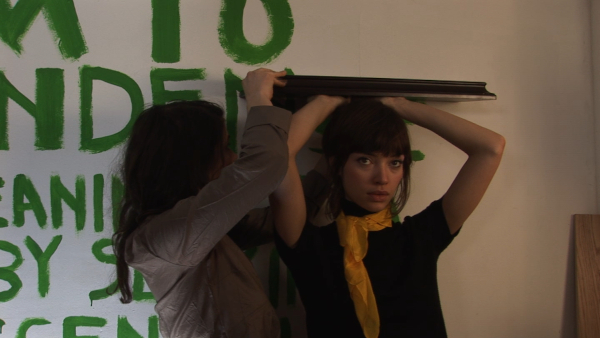
By then, I had some hopes that The Lion’s Den could reach a small audience. It is aggressively philosophical but also features a love triangle, a car chase and a final shootout. Its comic style, I was hoping, would attract people who were put off by the purposeful flatness of Annunciation. Nevertheless, the movie was also rejected from every conceivable festival. I now realized that submitting an aggressively experimental narrative film without a single famous person in it to festivals is basically like flushing your money down the toilet. Yet I continued submitting, like an addict at a casino putting all of their savings on the roulette table. You never know, right?
In hindsight, I now see The Lion’s Den as a very angry film that perhaps uses comedy to soften the blow of some of its hotheaded fervor, and suspect some of its critique of capitalism and naturalism came from hurt and jealousy. “You think my work isn’t natural enough, eh? I’ll show you motherfuckers naturalism!”
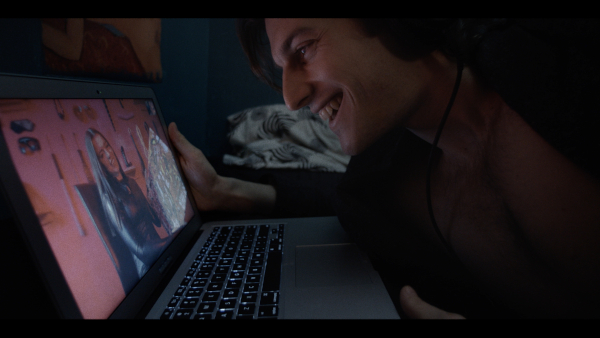
Sometime in 2017, to my surprise I became smitten with certain neo-neorealist filmmakers (Joe Swanberg, in particular) and decided I wanted in on the mumblecore party, albeit from my own outsider perspective. I began to see how I could work symbolically with naturalistic performances, which led me to my latest film. PVT Chat is by no means a work of strict realism, but nevertheless focuses on believable dramatic performances. The film’s cast blends some actors from my past work (Kevin Moccia, Nikki Belfiglio, David White) with some heroes of the modern neo-neorealist indie cinema (Peter Vack, Julia Fox, Buddy Duress, Keith Poulson).
I want to end with a bit of advice to other filmmakers: Don’t put your self-worth into the hands of festival reviewers or distributors. The future of the moving image will belong to the films that are willing to risk cinematic failure. If you make an earnest film that doesn’t behave like a normal movie, I want to see it, even if it is full of technical or narrative mistakes (which it most likely will be). There’s no right way to make a movie. Follow the dream of the caméra-stylo and make a film that if nobody else made, wouldn’t exist.
Featured image shows Ben Hozie and Jason Kng during the filming of Annunciation. All images courtesy Ben Hozie.


